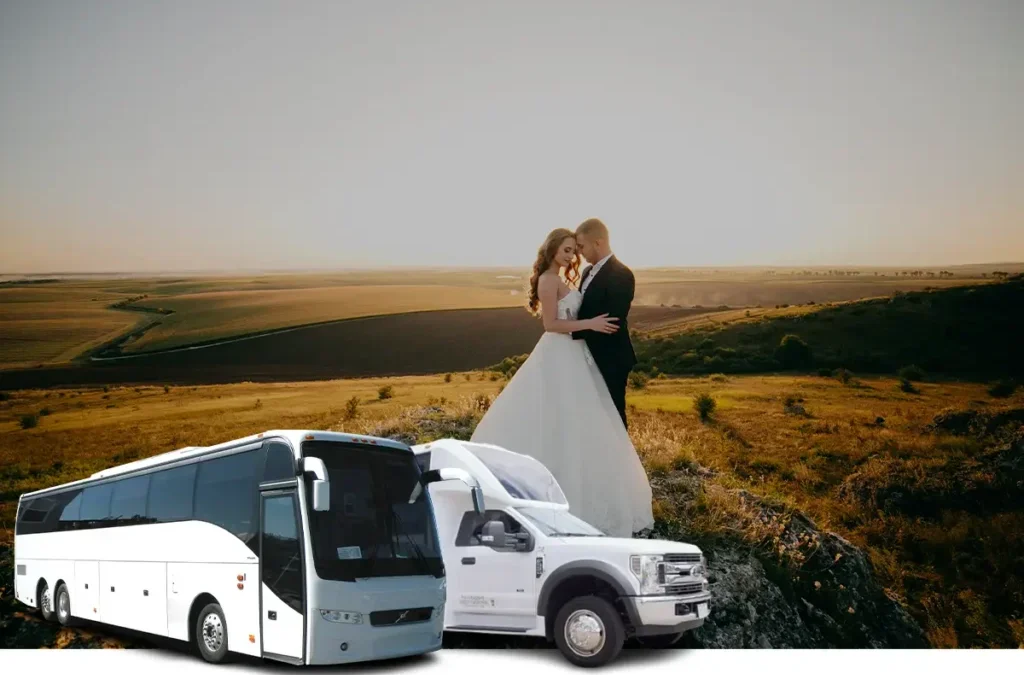A well-planned transportation strategy can quietly transform a wedding day from hectic to harmonious. In 2025, charter bus options make it far easier to move large groups efficiently between ceremony, cocktail hour, and reception—without leaving anyone guessing where to go. Skipping individual rideshares reduces confusion, saves time, and keeps your timeline intact while you focus on the moments that matter. If you want a straightforward way to avoid parking issues and guest delays, coordinating a dedicated shuttle network is a smart move. Discover Now how small planning choices, paired with professional operators, keep your event on schedule and elevate the guest experience for every leg of the journey, especially when you’re mapping out Wedding Transportation details.
Coordinating Guest Travel Between Ceremony and Reception
The gap between ceremony and reception is where the timeline can slip, so you’ll want to plan this segment with precision. Identify peak guest load times, then schedule shuttles in waves that reflect actual turnout—for instance, stagger three buses to arrive five minutes apart rather than dispatching a single oversized coach. Build in buffer time around photos and receiving lines, which almost always run longer than expected. Coordinate multiple pickup points—like hotels, a designated park-and-ride lot, and the ceremony site—so guests can choose whichever is most convenient. Finally, add visible signage and a text alert system to reduce confusion and keep everybody moving confidently to the reception.
Route mapping and timing fundamentals
Start by mapping the fastest and the most reliable routes, not just the shortest one; construction and weekend events can clog popular corridors. Share route plans with your coordinator and DJ so they can adjust the timeline in real time if needed, and ask the bus provider to monitor traffic and deploy backup vehicles. Create a simple boarding plan—families first, then by hotel block—to prevent bottlenecks and keep aisles clear. Use clear language in your invitations or website about where guests should meet the shuttle and the last departure time, highlighting that the final bus leaves promptly. With a few layers of redundancy—alternate stops, extra ice water on board, and a firm cutoff—you’ll maintain momentum and set the tone for a relaxed, well-orchestrated evening.
Tailoring Shuttle Schedules for Wedding Day Events
No two weddings run on the same clock, which is why custom shuttle schedules help you stay in control. Think of your event as a series of “mini-transfers”: rehearsal dinner, morning setup, beauty appointments, ceremony, cocktail hour, and reception exit. Assign the right vehicle size to each segment; a sprinter for the wedding party’s photo loop, mid-size buses for hotel pickups, and full coaches for ceremony-to-reception transfers. That mix avoids sending half-empty vehicles while ensuring there’s room when the entire guest list moves at once. Give vendors a shared timeline that shows when buses arrive, when doors open, and when last calls happen, so your planner, photographer, and venue managers remain aligned.
Building a shuttle cadence that fits your day
Draft your shuttle cadence around meaningful moments—vows, toasts, sunset portraits—to prevent collisions between logistics and memories. Offer early and late “waves” for guests with different preferences, such as families with children or night-owls who plan to dance through the last song. Embed schedule reminders on your wedding website and in hotel welcome bags, and provide a QR code linking to live updates. For cross-town weddings, schedule a midday test run with your provider to confirm timing under similar traffic conditions. Integrating these steps into your broader Wedding Transportation plan ensures every ride supports the flow of your day rather than interrupting it.
Reducing Parking Congestion With Group Transport
Parking often becomes the hidden stressor, especially at urban venues, vineyards, or estates with narrow access roads. Charter buses dramatically cut the number of arriving vehicles, easing strain on lots and nearby neighborhoods while smoothing the guest arrival experience. When guests don’t circle for parking or trek from distant overflow areas, they arrive calm, on time, and ready to celebrate. A strong park-and-ride system—leveraging hotel lots or a nearby corporate campus—keeps venue entrances clear and helps your attendants focus on greeting rather than traffic control. This approach also supports sustainability goals by consolidating trips and reducing emissions.
Smart staging and venue collaboration
Work with your venue to designate a bus-only staging lane for arrivals and departures, ensuring easy curb access without bottlenecking personal vehicles. Confirm turning radii, overhead clearance, and loading zones with your provider, and share that map with your planning team so everyone speaks the same language on event day. Plan tiered arrival windows for VIPs, elderly guests, and families with strollers to minimize congestion at the entry. Encourage non-shuttle guests to ride-share to your park-and-ride lot rather than the venue itself, reserving limited onsite spaces for those who need them most. With clear staging and a lean flow of private cars, the whole guest journey feels more gracious and less chaotic.
Ensuring Accessibility and Comfort for All Guests
Inclusive transport ensures every guest—regardless of mobility, age, or sensory needs—can participate fully in the celebration. When you book, request ADA-compliant coaches with lift access, wide aisles, and priority seating, then confirm in writing how many accessible spots you’ll have per run. Communicate pickup locations with precise landmarks and lighting notes, and make sure there’s a covered waiting area in case of rain or extreme heat. Let your provider know about walkers, scooters, or service animals so they can deploy appropriate equipment and trained staff. The aim is simple: make boarding seamless and dignified so comfort begins the moment guests step onto the bus.
Comfort features that elevate the ride
Comfort is more than cushioned seats; it’s a thoughtful environment tailored to a wedding’s pace. Ask for climate-controlled coaches, onboard restrooms for longer transfers, and low-entry steps where possible. Provide chilled water, small snack packs, and a discreet waste bag near each row to keep the space tidy during transit. Share a calm, friendly onboard script with your MC or designated host to welcome guests, explain timing, and set expectations without sounding rigid. These small touches, coupled with the right equipment and professional support, turn logistics into hospitality and make every ride feel like part of the celebration.
Enhancing Shared Experiences Through Group Travel
When guests ride together, the day begins to feel like a journey rather than a set of separate stops. You can curate this time with a short playlist of meaningful songs, a fun “how we met” audio snippet, or a quick icebreaker announced by a wedding party host. A group bus also reconnects family and friends who haven’t seen each other in years, offering laughter and conversation that would never happen in separate cars. For couples with multiple cultural traditions, this in-between time becomes a bridge that helps guests understand and enjoy each segment of the celebration. Discover Now how these shared moments create a stronger sense of community, which often shows up later as a more energetic dance floor and warmer toasts.
Onboard touches that make memories
Keep enhancements simple and considerate so they don’t feel like an obligation. Offer a mini welcome kit with a thank-you card, a small bottle of water, and a keepsake like a custom button or postcard tied to your story. Invite the DJ or playlist curator to balance energy, starting calm after the ceremony and building toward the reception. Include a gentle five-minute heads-up before arrival so guests can gather belongings and transition smoothly, avoiding a rushed exit. With a little planning, the ride becomes a meaningful chapter of your celebration rather than just a means of getting from point A to point B.
Using Professional Drivers for Stress-Free Transfers
Experienced drivers do more than operate the vehicle; they anticipate guest behavior and solve problems before they escalate. A seasoned team will spot when a stop needs to be moved ten yards for easier boarding, or when a second loop is warranted to pick up stragglers after photos. They coordinate quietly with your planner, adjusting timing without disrupting the mood or calling attention to hiccups. Professionals also maintain safety standards—from secure luggage compartments to careful ramp operation—so guests feel protected throughout. With expert drivers, your transportation plan becomes a living system that adapts to reality, not a brittle schedule that cracks under pressure.
The reliability factor that couples underestimate
Ask about driver tenure, wedding experience, and local route familiarity during booking, and request a point of contact who will be onsite. Ensure drivers receive the final timeline, venue diagrams, and contingency plans at least 48 hours in advance, with updates delivered by text the morning of the event. Provide a clear chain of command so your planner, venue manager, and transportation lead can make quick, confident decisions. Build in a debrief call after the rehearsal shuttle to capture last-minute refinements for day-of service. When you fold driver expertise into your broader Wedding Transportation plan, every transfer feels crisp, calm, and exquisitely managed.
Supporting Smooth Wedding Planning Through Reliable Transport
Transportation touches almost every vendor, which is why it belongs in your planning timeline from the start. Secure your buses shortly after booking venues, then hold a joint meeting with your planner and provider to shape routes, passenger counts, and timing. Share hotel block data as it evolves so the provider can resize vehicles and allocate backups. Keep a live manifest—names, pickup sites, accessibility notes—so everyone knows who should be on which shuttle, and update it as RSVPs change. A structured approach reduces day-of surprises and keeps communication flowing to the right people at the right times.
Integrating logistics into the master plan
Channel updates through a single source of truth, whether that’s your planning portal or a shared document linked on your wedding website. Add transportation checkpoints to the master timeline: when signage goes out, when text alerts begin, and when last-call announcements happen at each venue. Provide a short FAQ on your website about shuttle hours, bag policies, and the final return trip, and include the same details in hotel welcome packets. Reconfirm two days before the event—driver names, vehicle types, radio channels, and contingency routes—and send a friendly reminder to guests the morning of. With these habits in place, you give your Wedding Transportation the same care you gave your menu and music, and you can Discover Now how reliability turns into peace of mind when the day arrives.
Related posts
Categories
Recent Posts
Advertisement


